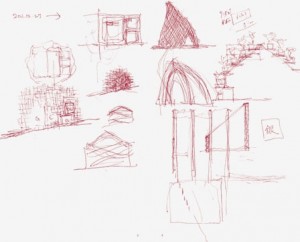 What’s a cave? In Primitive future, Sou Fujimoto presents criterions for the ideal architecture of the 21st century. His reflexion on innovation in designing space is based on the comparison between the cave and the nest, the cave being the optimum form of architecture. He suggests looking into the concept of a cave, a primal space that precedes the concept of inhabiting. The discussion is not about the cave in its formal appearance but rather the entity of the cave, a flexible format that allows us to project an infinite number of functionalities to it. The nest on the other hand refers to a container built with the intention of sheltering or receiving a home. This distinction established by Sou Fujimoto questions precisely the role of the architect in a contemporary world and how architecture forges links with nature to explore “whether something that is without purpose, or something that exceeds purpose can be made intentionally”.
What’s a cave? In Primitive future, Sou Fujimoto presents criterions for the ideal architecture of the 21st century. His reflexion on innovation in designing space is based on the comparison between the cave and the nest, the cave being the optimum form of architecture. He suggests looking into the concept of a cave, a primal space that precedes the concept of inhabiting. The discussion is not about the cave in its formal appearance but rather the entity of the cave, a flexible format that allows us to project an infinite number of functionalities to it. The nest on the other hand refers to a container built with the intention of sheltering or receiving a home. This distinction established by Sou Fujimoto questions precisely the role of the architect in a contemporary world and how architecture forges links with nature to explore “whether something that is without purpose, or something that exceeds purpose can be made intentionally”.
One of the main topics discussed is the manipulation of transitions, which creates space for interpretation (or reinterpretation). Sou Fujimoto focuses on vagueness and ambiguity. To create in-betweens is the ability to make a bundle of suggestions that can only exist through the relationships they have with each other. Space is then defined by the relationships themselves. It establishes a flexible architecture regulated by immediate interactions as opposed to fixed patterns. In this case form and content are no longer separate, they occur naturally and simultaneously.
The approach to 21st century architecture described by Fujimoto is the search of “otherness”. It is the creation of space that is loose enough to provide experiences that are different (innovative as opposed to new), and a multiplicity of these experiences. In his conceptual diagrams, he shows how simplicity of intention is paired with richness of experiences. The example of a tree drawn by a child and the complexity of an actual tree falls under the idea of intuitive understanding that can create a flexible framework much closer to the richness of reality. Sou Fujimoto depicts “incomprehensible”architecture that requires multiple levels of interaction with our senses.
What inspires me most about this excerpt is Sou Fujimoto’s take on the cave describing his idea of innovation in architecture but also the importance of a shift in perspective for the 21st century. Going back to the cave to find enlightenment, a thought provoking concept precisely because we are attached to fixed exclusive ideals and patterns of creating space. In Plato’s well known allegory of the cave, for instance, the cave is chosen to describe imprisonment, the whole process of enlightenment being breaking out of the cave . Sou Fujimoto’s definition of the cave transcends the weight of existing connotations of the cave. The “transparent cave” emerges and opens infinite possibilities where space is regulated by choices of interaction.
When choosing to let go of existing fixed grids/ideals we come up with a definition of space detached from form, based on relationships and involving every possible scale. I am particularly interested in the application of this ideology in an urban environment. Sou Fujimoto states that a city is a House of houses: how would it be possible to provoke transitions in the city that we know to give birth to transparent urban communities? What would be an urban cave?